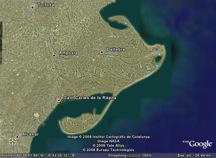Coastal Discussion: Difference between revisions
mNo edit summary |
mNo edit summary |
||
| Line 10: | Line 10: | ||
This wiki page can serve as the venue for these discussions. | This wiki page can serve as the venue for these discussions. | ||
Revision as of 15:47, 17 July 2008
Discussion page Coastal Working Group
At the March 8 meeting of the Coastal Working Group, we initiated the discussion about possible proof-of-concept projects, one of our short-term goals listed in the Strategic Plan:
- “Define proof-of-concept questions—questions that require linking together models of different environments, preferably spanning between coastal and terrestrial or marine environments. These should be examples of types of interesting and relevant scientific questions, but should have known answers, to allow evaluation of the pilot modeling endeavor.”
Although most of the Working Group members had not yet considered what projects could meet the criteria listed above, the Chair tossed out one example:
- How do land-use changes in hillslope/mountain environments affect coastline evolution, via altered fluvial sediment loads? The evolution of the Ebro Delta, Spain provides one known instance that we could try to reproduce, in which progressive deforestation in the mountainous watershed lead to the emergence of the delta, where an estuary previously indented the rocky coastline (Montsia Museum, Ebro Delta, Spain). Subsequently, reforestation and development in the watershed have reduced sediment loads, apparently causing the balance between wave driven sediment transport and fluvial delivery to shift and leading to a shift in the morphological evolution of the delta (Ashton and Murray, Coastal Dynamics ’05), producing the current distinctive shape (Figure below).
A proof-of-concept project should involve modeling challenges, and yet should be achievable within 5 years; models of the component environments should already exist. For the Ebro Delta example, candidate models would include the CHILD and Ashton-Murray models of terrestrial and coastal landscape evolution, respectively, and the moving-boundary nature of the coupling would provide a significant challenge.
Working group members stated that impressive data sets are available to evaluate this modeling project, ranging from millennial scale to modern processes, and that coupled models that were successful in this case study could also be applied to other wave-influenced deltas including the Brazos and Danube deltas. Working Group members agreed to propose other possibilities, and to discuss them in coming weeks and months.
This wiki page can serve as the venue for these discussions.

